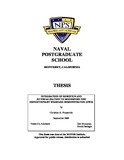Integration of robotics and 3D visualization to modernize the Expeditionary Warfare Demonstrator (EWD)
| dc.contributor.advisor | Brutzman, Don | |
| dc.contributor.advisor | Sadagic, Amela | |
| dc.contributor.author | Fitzpatrick, Christian R. | |
| dc.date.accessioned | 2012-03-14T17:42:10Z | |
| dc.date.available | 2012-03-14T17:42:10Z | |
| dc.date.issued | 2009-09 | |
| dc.identifier.uri | https://hdl.handle.net/10945/4520 | |
| dc.description.abstract | In the summer of 2008, the Commandant of the Marine Corps (CMC) released a message to all Marines and Sailors detailing plans to revitalize U.S. naval amphibious competency. Current responsibilities in Iraq and Afghanistan have significantly reduced available training time causing overall amphibious readiness to suffer. In response, this thesis evaluates 3D visualization techniques and other virtual environment technologies available to support these mission-critical training goals. The focus of this research is to modernize the Expeditionary Warfare Demonstrator (EWD) located aboard Naval Amphibious Base (NAB) Little Creek, Virginia. The EWD has been used to demonstrate doctrine, tactics, and procedures for all phases of amphibious operations to large groups of Navy, Marine Corps, Joint, Coalition and civilian personnel for the last 55 years. However, it no longer reflects current doctrine and is therefore losing credibility and effectiveness. In its current configuration, the EWD is limited to a single training scenario since the display’s ship models rely on a static pulley system to show movement and the terrain display ashore is fixed. To address these shortfalls, this thesis first recommends the usage of the wireless communication capability within Sun’s Small Programmable Object Technology (SunSPOT) to create robotic vehicles to replace the current ship models. This enables large-group visualization and situational awareness of the numerous coordinated surface maneuvers needed to support Marines as they move from ship to shore. The second recommendation is to improve visualization ashore through the creation of Extensible 3D Graphics (X3D) scenes depicting high-fidelity 3D models and enhanced 3D terrain displays for any location. This thesis shows how to create these scenes and project them from overhead in order to modernize the gymnasium-sized EWD into an amphibious wargaming table suitable for both amphibious staff training and operational planning. Complimentary use of BASE-IT projection tables and digital 3D holography can further provide smallgroup, close-up views of key battlespace locations. It is now possible to upgrade an aging training tool by implementing the technologies recommended in this thesis to support the critical training and tactical needs of the integrated Navy and Marine Corps amphibious fighting force. | en_US |
| dc.description.uri | http://archive.org/details/integrationofrob109454520 | |
| dc.format.extent | xxiv, 173 p. : (some col. ill.) ; | en_US |
| dc.publisher | Monterey, California. Naval Postgraduate School | en_US |
| dc.rights | This publication is a work of the U.S. Government as defined in Title 17, United States Code, Section 101. Copyright protection is not available for this work in the United States. | en_US |
| dc.title | Integration of robotics and 3D visualization to modernize the Expeditionary Warfare Demonstrator (EWD) | en_US |
| dc.type | Thesis | en_US |
| dc.contributor.corporate | Naval Postgraduate School | |
| dc.contributor.department | Modeling, Virtual Environments, and Simulation (MOVES) | |
| dc.description.recognition | Outstanding Thesis | en_US |
| dc.description.service | US Marine Corps (USMC) author. | en_US |
| dc.identifier.oclc | 468135 | |
| etd.thesisdegree.name | M.S. | en_US |
| etd.thesisdegree.level | Masters | en_US |
| etd.thesisdegree.discipline | Modeling, Virtual Environments, and Simulation Institute (MOVES) | en_US |
| etd.thesisdegree.grantor | Naval Postgraduate School | en_US |
| etd.verified | no | en_US |
| dc.description.distributionstatement | Approved for public release; distribution is unlimited. |
Files in this item
This item appears in the following Collection(s)
-
1. Thesis and Dissertation Collection, all items
Publicly releasable NPS Theses, Dissertations, MBA Professional Reports, Joint Applied Projects, Systems Engineering Project Reports and other NPS degree-earning written works. -
2. NPS Outstanding Theses and Dissertations





